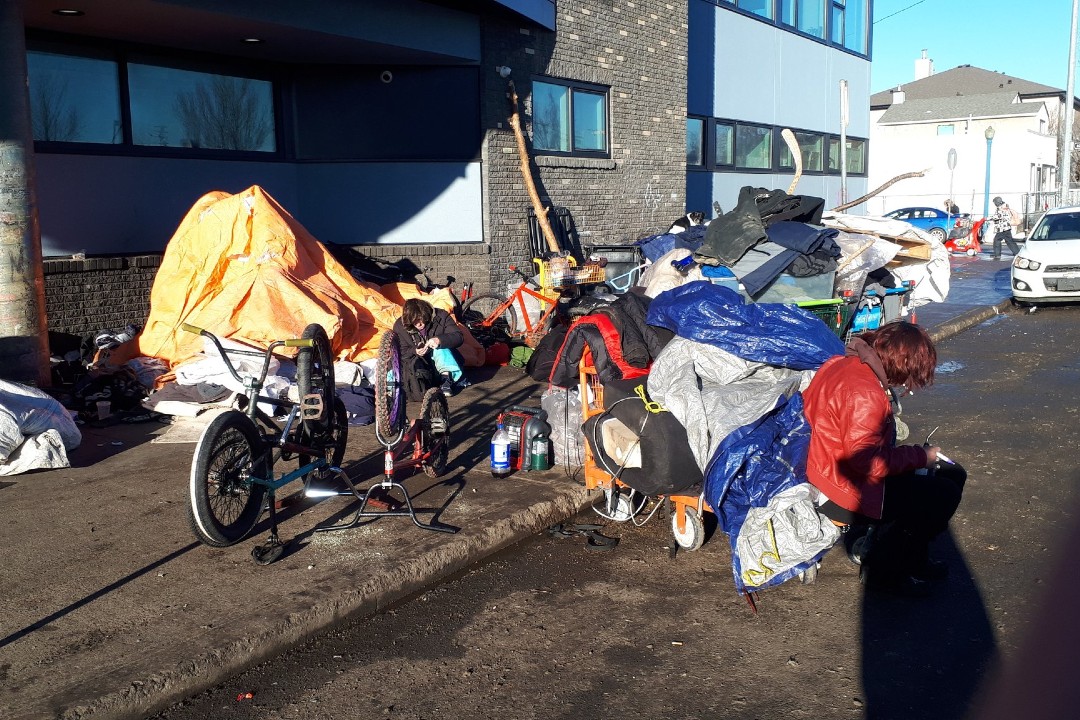The United Conservative Party government describes its recently-launched homeless reception centre as a success, but some advocates for people without housing strongly disagree.
The province launched a navigation and support centre out of a Hope Mission building in January. Jason Nixon, minister of seniors, community, and social services, said the centre was in the works for months and was created to connect homeless people to housing, identification cards, and health and addiction services. "Alberta's government has worked closely with Edmonton police and fire rescue, Indigenous partners, Alberta Health Services, and local shelter providers to come up with a strategy to take people from encampments and connect them to supports and services that will help them get back on their feet," Nixon wrote in a Postmedia op-ed.
But Jim Gurnett, spokesperson for the Edmonton Coalition on Housing & Homelessness, said the centre has led to "abject misery" for many. Before the centre, a person sleeping rough would only have their shelter removed every two or three months, Gurnett said. Now, removals can happen daily. Gurnett added that because of these frequent removals, any belongings a person can't carry with them are now at risk of being thrown out and lost. "A lot of the people that I'm connecting with now, they've got nothing left except maybe a blanket or a single tarp," he said.
Gurnett also said the province's response is, counterintuitively, increasing people's physical danger and attacking their mental health, too. When a person's tent is repeatedly removed, "you cannot keep your spirits up, you cannot keep a positive sense about your life," he said.
Even though some homeless people choose to sleep outdoors instead of using the shelter system, Nixon said encampments are not the answer. "Encampments are unsafe and only lead to vulnerable Albertans being victimized and exploited," he said. "Alberta's government cares deeply about vulnerable Edmontonians and we will always ensure that anyone who wants shelter and supportive services will receive it."
Heather Barlow, Nixon's press secretary, told Taproot the centre has seen more than 415 people and made more than 1,500 referrals. More than 200 people have been connected with health services, and 70 with mental health and addiction support, including 22 people who have started opioid agonist therapy. Barlow added that more than 150 people have been referred to housing programs and more than 220 people have been connected to emergency shelter spaces, including about 70 people who were linked to transitional housing or bridge housing.
But Gurnett said these referral numbers tell only part of the story. "Just being taken to the reception centre says nothing about whether anything has improved in your life," he said. "From that experience, what you might have done is leave there an hour later with a few pamphlets in your pocket, and still had to find somewhere to sleep that night."
Gurnett added that the province's centre provides services that were already offered by providers like Boyle Street Community Services, Mustard Seed, and Bissell Centre. "The people that work (at the provincial reception centre) are good-hearted people who do want to help, but it was a redundant thing developed with no consultation or research about what was really needed," he said. "So it's costing a lot of money, and it doesn't really add to the available services in the community."

This encampment near the Bissell Centre was subsequently removed. One advocate says the push to eradicate encampments due to safety concerns is counterintuitively making life less safe for those living without housing, and leading to a miserable life where people often lose their belongings due to frequent evictions. (Supplied)
Bryce Ward of Tawâw Outreach Collective, an Indigenous-led aid organization, told Taproot that not all who see their encampments removed go to the reception centre, and many move their camps to other areas, especially in the Strathcona neighbourhood. "We honestly feel (the homeless population has) doubled on the (city's) south side, because everyone on the north side is pushing them over to that side," Ward said.
The province did not respond to a question about whether displaced homeless people are moving encampments to other parts of the city.
A spokesperson for the Old Strathcona Business Association said in an email that it hasn't noticed an increase in social disorder recently, and that the beat police officers who patrol the area have told it they have seen a decrease in social disorder in recent weeks.
Ward said the province's centre is cutting vulnerable people off from support systems. "We have no idea where these people are … On the streets downtown, it's less and less (people), and we know it's not because folks are being housed."
The province did not say how many people who were connected with housing support in the approximately six weeks the centre has been open are now permanently housed.
Barlow said the centre has allowed more homeless Edmontonians than ever to be connected to services. "By receiving services and supports at the navigation and support centre, people increase their formal and informal connections to a variety of resources and supports such as shelter, access to a housing worker, medical services, and identification," she said.
Gurnett said he is disappointed by the latest approach to homelessness in Edmonton and that something better could have been developed by consulting those living on the street.
"When there was a lot of public attention and concern about people that were living on the streets and living in informal shelters, we had the opportunity to do something very different and very much better," he said. "What I see happening is that opportunity slipping away."
